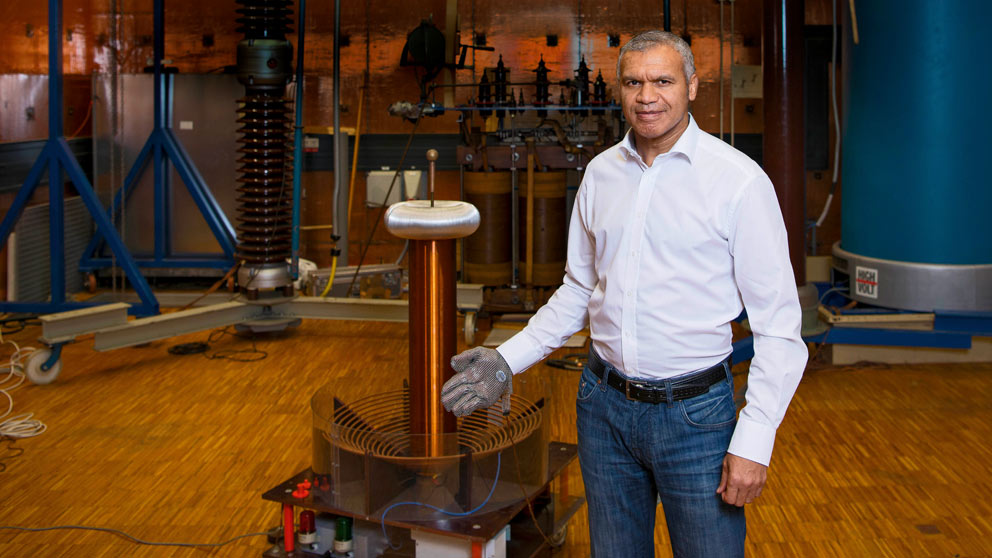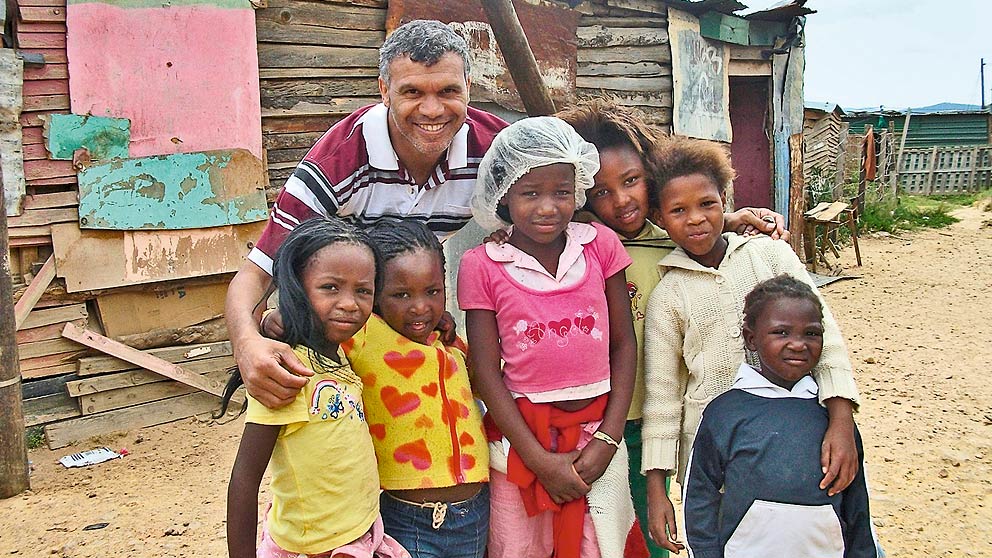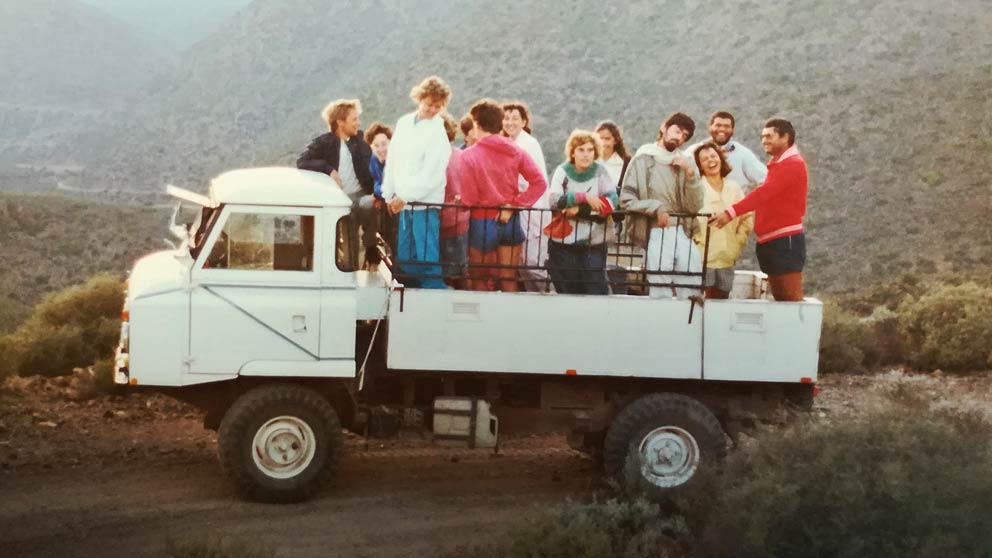Jump to the content
- {{#headlines}}
- {{title}} {{/headlines}}

Dr Wilfred Leslie Owen Fritz was born in Cape Town, South Africa, on 6 December 1962. At the height of the apartheid regime in 1981, he was one of the first non-whites to be admitted to the University of Stellenbosch, completing a Bachelor’s degree in engineering in 1987.
After working outside academia for many years, Fritz returned to university in 2001. At the Cape Peninsula University of Technology (CPUT) in Cape Town he firstly took an M.Sc. and an M.Eng. in electrical engineering, following it up with a Ph.D. which was awarded in 2011. Today, he is an associate professor at CPUT.
In recognition of his scientific achievements, Wilfred Fritz received the Young Researcher Award from the African-German Network of Excellence in Science (AGNES) in 2012. The network had been launched with the support of the Alexander von Humboldt Foundation to promote research collaboration and academic exchange between Africa and Germany. As an AGNES award winner, Fritz was invited to the Humboldt Colloquium in Nairobi in 2014 and subsequently applied for a fellowship under the Georg Forster Programme. Since the beginning of 2017, Wilfred Fritz has been a Georg Forster Fellow, continuing his research at the Institute of Energy Transmission and High Voltage Engineering at the University of Stuttgart.

Stellenbosch, summer 1981: hundreds of first years stream onto the campus of the prestigious white South African university, east of Cape Town. They have just sat down at the Faculty of Engineering when a young man enters the room. “Everyone stared at me, there were hostile looks and nervous whispers,” Wilfred Fritz recalls many years later. The 18-yearold had to sit alone – none of the other students wanted to get anywhere near him in class. Nothing much changed in the years that followed up to his final exams in 1987. Fritz is a Cape Coloured, an ethnic group whose forefathers were European immigrants, indigenous Africans and Asian slaves.
It was the apartheid years in South Africa and, by law, the white upper-class students were kept well apart from their darker-skinned fellow citizens – not just at university but also on the bus, at church and in the sports stadium. “As soon as it got dark, we were no longer allowed to show our faces in white areas,” Wilfred Fritz remembers.
In the apartheid hierarchy, being coloured was second after being white. Coloureds had more rights than Indians and vastly greater privileges than the black majority of the population. “This racial system was brainwashed into all South Africans from early childhood and is still in people’s heads to this day,” says Wilfred Fritz.

But he soon managed to overcome the restraints imposed by his descent. Born to a male nurse and a housekeeper in Cape Town in 1962, he grew up in a Coloured residential area. His mother was illiterate. Schooling was by no means obligatory and many neighbours took their children out of school early to work. But the Fritzes sent their three sons to school every day – until they had taken their final exams.
Wilfred was particularly gifted, hard-working and lucky. Just as he was leaving school with top marks, the government opened up a few places for Coloureds at white universities for the first time. The young man applied to Stellenbosch and was accepted. Difficult years ensued: getting up at five in the morning, a two-hour journey to the campus, likewise in the evening and then an enormous workload in his chosen field of electrical engineering. “Unlike the white students, I had never heard of differential and integral calculus when I was at school,” Fritz recalls. But he fought his way through and, within a year, was one of the best in his mathematics course.
No money, no uni
Everything could have come to an abrupt end at this point: his parents did not have enough money to pay his academic fees in full – their son was in danger of being barred from university. Then the Dean of the Engineering Faculty, Christo Viljoen, asked to look at his academic marks. Impressed by his achievements, Viljoen immediately arranged a loan to last until he had passed his B.Eng. “If I could only meet up again with one single white person from my youth, it would be him – I have so much to thank him for,” says Wilfred Fritz thoughtfully, gazing out of the window of his office at the University of Stuttgart.

Here, in the Institute of Energy Transmission and High Voltage Engineering, the now 55-year-old electrical engineer sits in front of a gigantic plan of lines, symbols and figures. “That is the power grid of Beaufort West, a small town 400 kilometres north of Cape Town,” Fritz explains. He wants to use it as a model to demonstrate the effects of feeding renewable energies into the grid and show what measures are needed to ensure a stable energy supply. Thanks to a Humboldt Foundation’s Georg Forster Research Fellowship, he can now spend a good two years researching solutions and trying out his computer simulations on a small scale in the institute’s own high-voltage laboratory.
The results of this research could have a major impact on South Africa’s future energy supply. At present, the government still mainly favours the environmentally-harmful generation of electricity from indigenous coal reserves. And according to Wilfred Fritz, there is serious talk of building new atomic power stations, although the sunsoaked country is obviously pre-destined to produce solar energy and to use wind power along its coasts. By 2030, the engineer believes, the share of power from renewables could realistically be increased from its present four percent to approximately ten percent. But before this can happen, it is necessary to get a grip on the problems of supply quality that can occur when feeding solar and wind power into the grid.
At the University of Stuttgart, the suitable computer models are being developed by the research group headed by Krzysztof Rudion, Wilfred Fritz’s mentor during his research stay in Stuttgart. “I can implement these models,” Fritz says, “and I hope I’ll soon be able to produce useful applications that will assist my country.” He is planning to continue his cooperation with the Stuttgart team after he has returned to South Africa. Relevant projects are already on the drawing board.
Wilfred Fritz has never been an ivory-tower researcher – for one thing, he could not have afforded it. After obtaining his degree at Stellenbosch, which four of the ten coloured pioneers managed, he immediately had to earn a living. He had just married, and the first of five children was on the way. So in 1989, the year Nelson Mandela was released from prison, Wilfred Fritz signed on with the South African branch of Siemens. “My supervisors sent me to a mine in Johannesburg,” he reports. “A young white foreman immediately confronted me and threatened to beat me up if I touched any of his equipment.” The bosses apologised for this behaviour, but Fritz soon resigned and moved to the public utilities company in Cape Town.

There he worked for a good ten years. Then in 2001, more than a decade after completing his first degree at Stellenbosch, he took up his academic career once again. At the Cape Peninsula University of Technology, known as CPUT, he acquired an M.Sc., an M.Eng. and a doctorate. And during the same period, four of his five children attended university as well: two of them also at CPUT and two at Stellenbosch, the formerly white university that is now open to all sections of the population.
In order to support his four daughters and son, while doing his own postgraduate degrees, Wilfred Fritz taught courses at the university. During the practical phases of these courses, he and his students connected many homes in a township to mains electricity. He also taught young researchers how to develop energy-saving devices, leading to the creation, for example, of a solar cooker that automatically tracks the sun and does not have to be manually adjusted. This useful invention has received a number of awards, such as the first prize in the international xplore New Automation Award competition in 2015 and a place in the final of the 2017 Africa Prize.
He still has to fight, even today
Wilfred Fritz is now a professor at his university, CPUT. Along the way, he had to overcome enormous obstacles and suffer many humiliations. How did he manage where so many of his contemporaries failed? Where did he find the strength? Wilfred Fritz ascribes it to a very happy childhood, his years in the Scouts, his parents’ enthusiasm for education and his helpful mentors, adding: “And I’m not a subservient Coloured and will never allow racist white people to oppress me.”
But he still has to fight to this very day. Although CPUT, like most other South African universities, is now under the leadership of black top management, the powerful middle management is still firmly in white hands, Wilfred Fritz reports. It practices hidden apartheid and systematically victimises people of colour. “Research funding raised by non-whites is held back or their travel is not authorised.” In cases like this, the self-confident researcher approaches the South African Engineering Council for support or appeals directly to the university top management: it was only thanks to their intervention that his research stay in Stuttgart was approved.
In Germany Wilfred Fritz feels free. “Here I’m not judged by the colour of my skin but by my performance and behaviour.” He lives in an apartment in the centre of Stuttgart, trains for half-marathons three times a week and plays tennis with colleagues. And he has gradually got used to some of the special traits of his host country. “People don’t beat around the bush, they get straight to the point, and meetings don’t start late, but very punctually.” In Germany, the emphasis is on the rights of the individual; in his country, by contrast, the rights of one’s own group determines your fate.
During apartheid, this was quite an advantage to some, but group egoism tended to prevent South African society from growing together: “We will need at least another two generations before we completely abandon the old ways of thinking,” Wilfred Fritz predicts. In his own life he has already made a good start.
